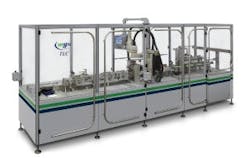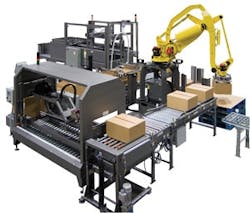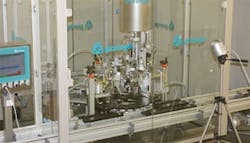But every control system has a lifespan, and sooner or later you'll have to update or replace it. Has your time arrived? How do you tell?
"Other reasons why we periodically upgrade our automation systems include improving HMIs and help screens, the need to control robots from a common machine control platform, improvements to servo performance and control, better data collection and tracking, automated data transfer to devices such as printers, and the need for vision systems and vision inspection," Bahr concludes.
Bill Stewart, president of Stewart Engineering, a system integrator in Boerne, Texas, says, "Factors that determine if a machine should be upgraded include the use of old relay logic, no documentation or discontinued hardware."
Obsolete parts and discontinued software support just aren't the leading reasons to update control systems. Instead, two key questions need to be answered, says Dan Jensen, senior automation engineer with Nelson Sales of Muskego, Wisconsin: "Does the machine work well now, and will it stay working?"
Darren Elliott, global technical resource manager at Rockwell Automation, says customers will tell you when it's time to upgrade. "When an OEM's customers start to ask for the latest and greatest control system features, it could be time to upgrade, since those end-user pain points often dictate the need for machine upgrades," he says. "For example, end users might need to lower maintenance costs, or they could be experiencing frequent nuisance trips and need a more reliable machine."
Jensen sees another sign: "Does the computer software work on newer laptops, or do you keep an old one with special software on the shelf just in case?" Some machine builders keep a PC/XT laptop with floppy drives around for this reason.
Maintaining legacy systems can get expensive as older components can have high failure rates. "Failure of obsolete components are generally unpredictable and almost always occur at the least convenient time," says Phil Gilkes, director of product support at Intelligrated, a builder of material handling equipment in St. Louis. "The downtime can result in significant costs to the end user."
Finally, it could be getting harder to sell the kind of controller you've been using. "Traditionally, robot manufacturers used their own proprietary controller, which was complicated to program and had to be interfaced with other system components," Gilkes says. "Now, complete robotic systems can be controlled by a single, powerful PLC. Customers are far more comfortable with PLC controls and tend to prefer systems and vendors that use them."
The same is often true for machine controls based on old relay logic, ancient programming software and proprietary systems. The control system might work, but customers won't buy it.
Keeping Up With Customers and StandardsSometimes a legacy control system can have none of the problems noted above, but it just can't handle all the new tasks that have come up in recent years. Michael Senske, president/CEO of Pearson Packaging Systems in Spokane, Washington, sees two major reasons to upgrade—a need to communicate with other machines, and the need for a modern HMI. "Many of our customers want to integrate machines to operate as a unified system, and they want to pull performance data from each machine for their ERP system," he explains. "A modern HMI lets customers more easily accomplish changeovers, perform routine maintenance, and monitor machine or system performance." Pearson makes top-loading case packing equipment, and offers secondary packaging solutions using robotics, case packers, case erectors, bag inserters, uncuffers, and case sealers (Figure 2).
"More manufacturing plants are integrating the machine control with MES and ERP systems," adds Rick Roszkowski, senior director of marketing at Cognex. "If your current automation system cannot provide the data needed by these systems, it might be time to upgrade."
Safety also is an issue. "Safety standards have become more stringent over the years, and older machines generally can be made much safer with an investment in controls," says Roger Rosinski, plant manager at All American Poly in Piscataway, New Jersey.
Machine builders worldwide have to meet new safety standards, such as the European Machine Safety Directive (EN ISO 13849-1 or EN IEC 62061). But for machines that meet standards in their market areas, safety upgrades might not offer value. "If the existing systems work fine and meet current safety requirements, then there's no compelling reason to change," says Steve Malyszko, president of Malisko Engineering, a system integrator in St. Louis. "Also, some customers might require the safety system to be separate from the main automation platform, negating one of the benefits of a control system upgrade."
Figure 2: Pearson Packaging Systems sees two major reasons to upgrade: a need to communicate with other machines, and the need for a modern HMI. Pearson's automated end-of-line packaging products use modern control systems and robotic solutions to provide customers with increased output, reduced waste and lower overall long-term production costs.
Bill Stewart looks at the safety issue from a different angle. "Safety is a big reason to upgrade," he says. "By integrating safety into the automation platform, you not only meet new standards, you also ensure there's no possibility of conflict between the automation and the safety systems."Nelson Sales' Jensen stakes out the middle ground, saying, "A safety-networked architecture has to be large and duplicated to be cost-effective. Safety in a robot cell could be easier to do with discrete components such as a door interlock and a couple of E-stops. Sometimes it's better to use the KISS method."
An integrated automation and safety system is the accepted norm for most industries, says Joe Sebastian, senior systems engineer with system integrator Optimation, Independence, Missouri. "If the existing system is proven safe, however, then safety is a hard sell by itself. Many old machines don't have safety mechanisms built in, so safety can't simply be added without major mechanical changes."
The most compelling safety-related reason to upgrade often is based on an assessment of the system itself to determine if it meets current standards, which change as new legislation is developed.
Can We Talk?One of the big advantages of a modern system is you get the latest communications capabilities such as Ethernet, digital motion networks, CAN-based networks, wireless, and Web access and server capability. Communications is just easier with newer systems.
"With the evolution of communication standards, there's no reason that manufacturer-to-manufacturer communications can't be done easily," says Michael Gurney, CEO at systems integrator Concept Systems in Albany, Oregon. "If you're considering hardware that is difficult to interface to other automation components, you might want to reconsider using that supplier."
Figure 3: Groninger makes filling and packaging machines with modern communications to enable connection to other machines, HMI/SCADA systems, the Internet and ERP systems, and lets machine builders do remote diagnosis and maintenance.
Modern communications open up a whole new world for OEMs and their customers by allowing connection to other machines, to HMI/SCADA systems, to the Internet, and to high-level enterprise software such as ERP systems. They also let machine builders do remote diagnosis and maintenance over the Internet. "We worked with Phoenix Contact to develop and implement a remote service function that allows a secure VPN connection, initiated by the customer," says Scott Ferguson, regional sales manager at Groninger in Charlotte, North Carolina. Groninger makes filling and packaging machines for the pharmaceutical and cosmetics industries (Figure 3). "Once the VPN connection is made, we're provided access to the PLC and HMI programs remotely," Ferguson explains. "Immediate troubleshooting, reduced service cost, elimination of travel cost and production support are just a few advantages this upgrade provides a customer."One Vendor or Two?If the discussion thus far has convinced you to upgrade your control system, now what?
AEMK Systems, a robot manufacturer in Waterloo, Ontario, probably goes through this more often than most OEMs, thanks to the rapidly changing nature of robots and applications. "The most significant changes in machine and robot building are controls and flexibility," says Rick de Jong, general manager. "Flexibility means a machine should be designed with product change in mind, with less fixed tooling, and a control platform that can be modified with minimal cost and time. Avoid the automation graveyard by ensuring that automated systems can be upgraded and modified, and also that the technology can be recycled into new applications."
Concept Systems encourages companies to standardize on a single vendor for similar functions, Gurney says. "For example, companies should standardize on a PLC manufacturer, an HMI manufacturer and a drive manufacturer. This minimizes spare parts and training requirements."
Which way to go from here is also a financial issue. "The overall cost of ownership needs to be considered," Gurney advises. "This includes maintenance costs, downtime costs, and the cost of not having something faster, more accurate, and/or more functional. These costs need to be considered over an acceptable ROI period."
Machine builders and system integrators are divided on whether you pick a single vendor partner, or work with multiple equipment and software suppliers.
"It's wise to focus on a single vendor that integrates various products to one common platform," de Jong says. "This reduces integration time and cost, provides faster service and support, reduces the training time, and eliminates the complexities of multiple vendor interfaces."
That's not necessarily so, says Nelson Sales' Jensen. "Using single-vendor systems usually means sacrificing capability for the sake of a name," he says. "Just because a manufacturer makes PLCs doesn't mean their control architecture for servo control is worthwhile. Nowadays, everything worth using comes with an Ethernet interface and will communicate via various protocols, so being limited to one manufacturer isn't necessary."
A single vendor can make that vendor's product less expensive. "From a purchasing perspective, the customer only has to deal with one vendor and thus can generally negotiate better discounts," argues Intelligrated's Gilkes.
But Malyszko of Malisko Engineering says the greater single-vendor discount might not add up to overall savings and better performance. "Individual vendors might provide very attractive price/performance for their specific products such as servo motors, bar code readers and vision systems," he rebuts.
Still, it could pay to standardize on a single vendor. Senske says Pearson Packaging Systems adopted Rockwell Automation's Logix platform and the PackML standard. "The Logix platform and PackML ensure consistent hardware and software architectures across the packaging line," he explains. "The primary benefit is that each machine in the packaging line uses standardized code that has been validated and is tried-and-true. This allows us and our customers to more easily maintain lines, as well as to add new functionality."
Optimation Optimizes Automation
Optimation is a vendor-neutral system integrator, servicing robot and machine builders along with other customers. Among other services, Optimation develops nesting and CNC part programming software for fabrication processes.
"Safety, efficiency, increased availability of spare parts, easier or less maintenance required, improved connectivity to other systems, higher production capacities, less operator involvement and quicker setup or changeover times have all initiated automation upgrades," says Joe Sebastian, senior systems engineer. He says that his company has added very simple automation to machines and doubled their production speeds.
"Changeover times are also a huge consideration," he notes. "New machines can automate a great deal of the product changeover process, or even do it on the fly, initiated directly from an MES system." Usually, it's some combination of these factors that add up to an automation upgrade with an acceptable ROI.
"In any automated environment, sharing data in real time is the key to efficient operation," says Duane Grob, vice president of engineering at Optimation. "Without a means of sharing and communicating information with other subsystems, all actions are basically reactionary."
Many older systems don't integrate well with an overall automated environment, Grob adds. "Another related item is smart I/O communications for gathering more detailed device status," he says. "Some device information is simply inaccessible, unless smart I/O platforms are incorporated in the overall system design. The data gathered from these devices can enable better decisions about maintenance, OEE and system performance, as well as inform plant personnel on modifications needed to continue operations."
Keep What Works
Many machine control systems have major components that still work well, even if the computer-based controller is obsolete. In such systems, it pays to keep what works and replace the rest.
Dan Jensen, senior automation engineer at Nelson Sales in Muskego, Wisconsin, says the real issue is whether the machine works well overall. "In the case of older hydraulic systems, their on/off nature and abrupt directional or velocity changes often wear out parts and mean headaches for maintenance personnel."
Jensen says simply removing the old directional valve and using a new hydraulic proportional servo valve and a motion controller can reduce machine stresses and prolong life. In many cases, older hydraulic and mechanical components are still completely functional for the job, but can benefit simply by using better closed-loop controls. "The machine builder can often cut costs by keeping the hydraulics and mechanicals, and replacing just the controls," he says.
Jensen did just that with a welding system he upgraded for a customer. The system required a positioning device that could survive lots of weld splatter, and his company used the existing hydraulic system. "We added a linear magnetostrictive displacement transducer for positioning a slide that held the assembly being welded, a Mitsubishi PLC, an operator screen, and a Delta Computer Systems motion controller," he says.
When Is It Time to Upgrade
- Control system is too expensive to maintain
- Customers are asking for new features
- Can't communicate with other systems
- Vendor documentation isn't available
- HMI makes changeovers and maintenance difficult
-
Can't meet safety needs
Reasons to Upgrade
- Integrates safety and control
- Makes machines more flexible
- Provides modern communications
- Increases reliability
- Makes programming easier
- Speeds troubleshooting and maintenance
Go to a Single Automation Vendor?
Yes, because:
- Fewer communications networks
- Safety systems integrated into controls
- All the components work together
- No multi-vendor finger-pointing
- Many of the OEM's customers specify the single vendor
No, because:
- Can't use best-of-breed for each component
- Most products work together these days anyway
- Will usually cost more up front
- Locks OEM into one vendor
- Customers may prefer a different single vendor
System Intefrator View
"Generally, the simpler a system is, the more reliable it is," says Keith Jones, president of system integrator Prism Systems (www.prismsystems.com), Mobile, Alabama. "Reducing the number of interfaces, or the complexity of these interfaces, is definitely a step in the right direction. Moving to a single-vendor solution can help by ensuring a consistent technology across multiple machines."
Newer control platforms integrate safety tightly with machine control, he notes, adding, "This allows the programmer to meet the safety objectives of the project and minimize machine recovery time from a safety interruption."
Older safety systems might use safety relays and hardwired safety interlocks to stop the equipment. If an emergency stop occurs, these devices frequently cut power to critical components and leave the system in an unknown state. "Once an E-stop is reset, there could be a startup sequence to place the machine back into production," Jones says. "A better safety strategy can reduce the complexity of the re-start sequence and place the machine back in service faster."
Communication enhancements in newer control systems allow machines to become more integrated with the rest of the plant floor, Jones says. "Some control vendors have communications interfaces that allow equipment on the plant floor to be reconfigured without programming changes," he adds. "An example is Siemens' iMap application that allows you to implement machine-to-machine communications from a graphical drag-and-drop interface. Applications like this allow plants to easily reconfigure their production equipment."
About the Author

Leaders relevant to this article:






